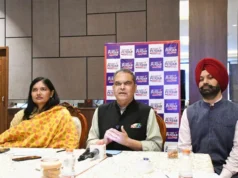Hyderabad: At 7 feet tall, stretching 14-18 feet in length, and weighing nearly 2,000 kg, the Murrah bulls from Haryana are set to be the stars of this year’s Sadar Festival in Hyderabad. Among them are Gholu II, from Super Dairy Farm in Musheerabad, and Bahubali from Dalbir Singh Dairy Farm.
Roaming through the Nawabi architecture surrounding the farm, Gholu II exudes a princely presence. True to its pampered status, the bull is fussed over when it eats, preferring mango leaves over apples. Alongside its refined eating habits and imposing stature, the bull’s polished black coat and gleaming horns add to its majestic look.
A display board at the Super Dairy Farm features a picture of Gholu II’s owner, Narendra Singh Poonia, receiving the Padma Shri award from President Ram Nath Kovind. Poonia, from Didwari village in Haryana’s Panipat district, was honoured in 2019 for his dedication to raising Gholu II.
Sandeep Yadav and Laddu Yadav have brought Bahubali, a bull they proudly call the “All-Time Animal Husbandry Champion.” “He’s the tallest and longest bull,” claims Sandeep Yadav while noting how it is also featured in the Telugu movie, Skanda. Together, these bulls promise to make this year’s Sadar Festival quite a spectacle.
Named after the hit film, Bahubali’s daily diet includes 25 litres of milk, 20 eggs, and three kilograms of dry fruits. This diet extends further, with claims that on four Sundays a month, Bahubali drinks a full bottle of Black Label whisky, consumes 20 litres of milk, 19 kg of apples, and enjoys laddu and an air-conditioned stay.
These high-maintenance bulls travelled 1,800 km to Hyderabad in air-conditioned containers, arriving in true Nawabi style.
Haribabu explained that the journey required meticulous attention: the bulls were given walking breaks, massaged with oil, bathed, and fed a diet rich in dry fruits, apples, pure ghee, and jaggery to ensure they arrived in peak condition. “It took seven to eight days to bring them here. They even sleep on rubber mats and have an air-conditioned room for comfort,” Haribabu shared.
Each bull will be shaved, groomed, and prepped to look their best for Saturday’s event. Last year, the Sadar Festival attracted five lakh visitors from the southern states. This time, organisers expect a turnout of 10 lakh, with visitors likely arriving from North India as well.
Now recognised as a state festival, Sadar celebrates these exceptional animals. With an average daily expenditure of Rs 5,000 to 6,000 per bull, the festival’s total cost exceeds Rs 35 lakh.
The term “Sadar,” derived from Hyderabad’s local dialect, traditionally refers to the community’s elder or leader. Dating back over 100 years, the festival originated as a means to unite the Yadav community. On the second day after Diwali, the community gathers with families dressed in new clothes showcasing their finest bulls. The best bull, selected on the criteria of size, stature, head, age, testicles gets the winning prize.
When asked why Ongole bulls from Andhra Pradesh are no longer part of the festival. The organisers explained that this breed, though originally from Andhra Pradesh, is now rarely seen in India. Most of the stock, they explain, have been exported to Brazil.
In states such as Haryana, Punjab, and Uttar Pradesh, government initiatives have established semen banks, making breeding more accessible to farmers. Gholu II’s semen alone generates Rs 15–20 lakh per month for its owner. Each bull produces 100 doses of semen and thus offers immense breeding opportunities.
Haribabu urged the Telangana government to implement similar veterinary services and semen banks to support local farmers. “A normal cow produces 1-2 litres of milk morning and evening, but this breed can yield 6-7 litres, which could greatly benefit farmers.”





